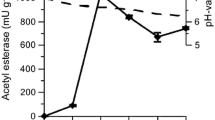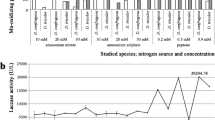Abstract
To examine the effect of vanillin on the production of the wood-decomposing enzymes of a wood-rotting fungus, vanillin was added as a model of lignin-related phenols to Coriolus versicolor cultures containing cellulosic and xylan substrates. Among five conditions tested, cellobiose alone was the most effective inducer of cellulolytic and xylanolytic enzymes. Addition of vanillin enhanced the effect of cellobiose on enzyme production. However, vanillin did not act as greatly in other cultures, except for cellobiose. Analytical isoelectric focusing and active staining of endo-Β-1,4-glucanase demonstrated that isozyme patterns in the presence of vanillin were the same as those in absence of vanillin, indicating that vanillin does not induce novel isozymes but rather enhances enzyme production. On the other hand, vanillin, which enhanced production of phenol-oxidizing enzymes, was not always determined in all cultures, suggesting that the action of vanillin depends on the kinds of carbohydrates. Therefore, the effect of a monolignol vanillin on enzyme production was associated with coexistent carbohydrates.
Similar content being viewed by others
Author information
Authors and Affiliations
About this article
Cite this article
Tsujiyama, Si. Effect of vanillin on the production of wood-decomposing enzymes from a wood-rotting fungus, Coriolus versicolor . Mycoscience 44, 345–350 (2003). https://doi.org/10.1007/s10267-003-0119-y
Received:
Accepted:
Issue Date:
DOI: https://doi.org/10.1007/s10267-003-0119-y




